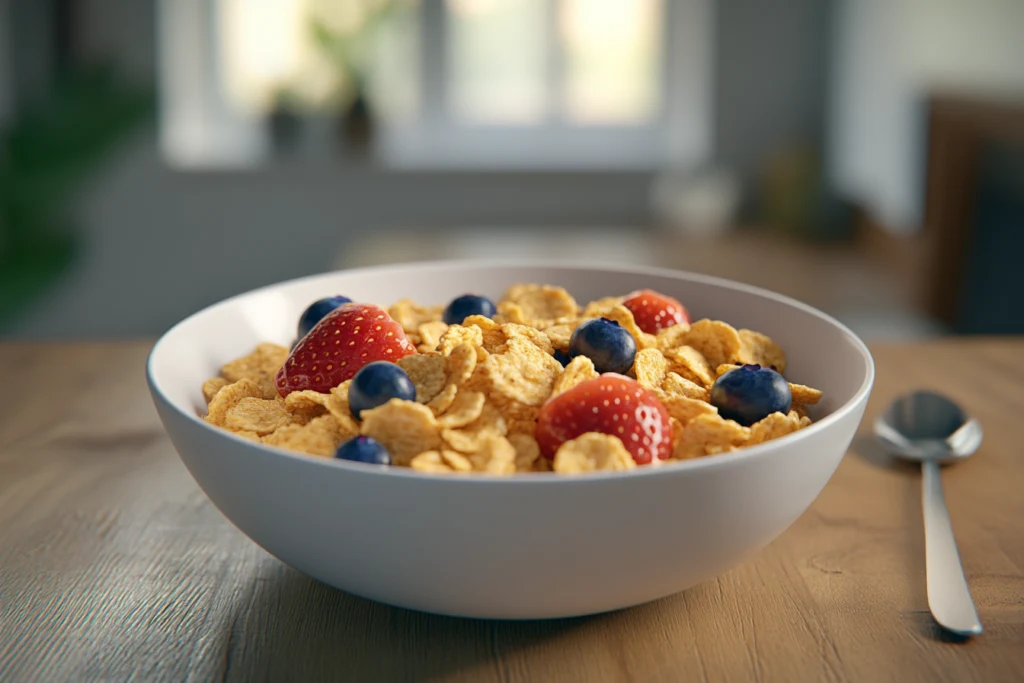1. Introduction to Protein Cereal
Protein cereal has gotten to be a well known choice for health-conscious individuals looking for a quick and nutritious breakfast. Packed with protein, it gives a adjusted combination of flavor and fundamental supplements, making it suitable for fitness enthusiasts, dieters, and active professionals.
In recent years, this breakfast choice has gained traction for its capacity to support muscle growth, help in weight management, and offer energy-boosting benefits. Unlike traditional cereals that are high in sugar and carbohydrates, protein-enriched cereals focus on delivering more protein and fiber, keeping consumers fuller for longer.
This article explores everything you need to know about protein cereal, including its benefits, types, recipes, and top brands. Whether you are looking to fuel your workout, stick to a low-carb diet, or enjoy a healthy snack, this guide has you covered.
2. What Is Protein Cereal?
Protein cereal is a modern twist on traditional breakfast options, offering a healthier alternative for those prioritizing nutrition. It is formulated to provide higher protein content while minimizing sugar and carbohydrates, making it ideal for fitness enthusiasts and health-conscious individuals.
2.1 Definition and Composition
Protein cereal is created based on ingredients like whey protein isolate, soy protein, pea protein, and whole grains. These components are combined with natural sweeteners, fiber, and vitamins to make a nutrient-rich meal option.
Unlike conventional cereals, which often focus on carbohydrates as the main energy source, protein cereal emphasizes protein as the primary macronutrient. This makes it suitable for muscle recovery, energy boosts, and satiety.
Many varieties moreover incorporate seeds, nuts, and dried fruits, offering extra fiber and healthy fats to adjust the nutritional profile.
2.2 How It Differs from Regular Cereal
The primary difference lies in macronutrients. Traditional cereals are typically higher in carbohydrates and sugar, providing quick energy but often leading to energy crashes. In contrast, protein cereal delivers a more sustained energy release due to its high protein and fiber content.
While a serving of regular cereal may contain around 2–4 grams of protein, protein-enriched options offer 10–20 grams per serving. Additionally, protein cereals often contain reduced sugar levels, making them better suited for weight management and low-carb diets.
The texture and flavor profiles also vary, with protein cereals available in crunchy clusters, flakes, or puffed styles to cater to different preferences.
3. Nutritional Benefits of Protein Cereal
Protein cereal is more than just a healthy breakfast, it conveys an extend of health benefits that make it a popular choice among fitness enthusiasts and those following balanced diets.
3.1 High Protein Content

Protein is essential for muscle repair, growth, and overall body maintenance. Most protein cereals contain between 10 and 20 grams of protein per serving, which is significantly higher than traditional cereals.
This high protein content helps maintain satiety, keeping hunger at bay for longer periods. As a result, it reduces cravings and supports weight management by minimizing the tendency to snack between meals.
Protein also plays a key role in muscle recovery, making these cereals an ideal option for athletes or those with active lifestyles.
3.2 Low Sugar and Carbohydrates
One of the standout features of protein cereal is its reduced sugar and carbohydrate content. Many brands focus on offering low-carb varieties, making them suitable for ketogenic and low-carb diets.
Traditional cereals often contain 10–15 grams of sugar per serving, while protein-enriched options usually have 1–4 grams. This helps prevent energy spikes and crashes, providing a more sustained source of energy throughout the morning.
3.3 Added Nutrients and Fiber
Protein cereals are often fortified with vitamins and minerals such as calcium, iron, and magnesium, supporting bone health and energy metabolism. They also include dietary fiber, which aids digestion and promotes gut health.
The inclusion of ingredients like flaxseeds, chia seeds, and oats enhances fiber content, further contributing to feelings of fullness and improved digestion.
4. Types of Protein Cereal
Protein cereal is available in several varieties, catering to different dietary needs and preferences. From animal-based proteins to plant-based and gluten-free options, there is something for everyone.
4.1 Animal-Based Protein Cereal
Animal-based options primarily rely on whey protein isolate, milk protein, or casein as the primary protein source. These cereals are particularly popular among athletes and fitness enthusiasts due to their complete amino acid profile, which supports muscle recovery and growth.
They often come in flavors like chocolate, vanilla, and cinnamon, mimicking classic breakfast cereals while offering enhanced nutritional value. These cereals are ideal for those following high-protein diets or looking for post-workout recovery meals.
4.2 Plant-Based Protein Cereal
Plant-based varieties are designed for vegetarians, vegans, and individuals with lactose intolerance. These cereals incorporate proteins derived from peas, lentils, quinoa, and brown rice.
In addition to being high in protein, plant-based cereals often contain more fiber, promoting better digestion and prolonged satiety. Popular flavors include almond crunch, maple cinnamon, and berry blends, offering diverse options for flavor preferences.
4.3 Gluten-Free and Low-Carb Options
Gluten-free protein cereals cater to those with gluten sensitivities or celiac disease. Made with almond flour, flaxseeds, and coconut flour, these cereals are not only free from gluten but also low in carbohydrates, making them suitable for ketogenic and paleo diets.
Low-carb versions focus on reducing sugar content while maintaining protein levels, ensuring they meet the needs of those managing blood sugar levels or following low-carb meal plans.
4.4 High-Fiber and Multigrain Variants
Some protein cereals emphasize fiber by incorporating oats, bran, and chia seeds. These are excellent for gut health and digestion while still providing a substantial protein boost.
Multigrain varieties blend grains like quinoa, millet, and barley, offering a balanced combination of protein, fiber, and essential nutrients.
5. How to Make Homemade Protein Cereal
Creating protein cereal at home is a simple and rewarding process. It allows you to control ingredients, flavors, and nutritional content while avoiding preservatives found in store-bought options.
5.1 Basic Recipe for Protein Cereal
Ingredients:
- 1 cup rolled oats or almond flour (base)
- 1/2 cup protein powder (whey, pea, or soy protein)
- 2 tablespoons chia seeds or flaxseeds
- 1/4 cup almond butter or peanut butter (for binding)
- 2 tablespoons honey or maple syrup (natural sweetener)
- 1/2 teaspoon vanilla extract
- 1/2 teaspoon cinnamon or cocoa powder (optional flavor)
Instructions:
- Preheat the oven to 325°F (160°C) and line a baking sheet with parchment paper.
- In a large bowl, mix the dry ingredients, including oats, protein powder, chia seeds, and flavorings.
- Add almond butter, honey, and vanilla extract to the dry mixture, stirring until it forms a sticky dough.
- Spread the dough evenly onto the baking sheet, flattening it with a spatula.
- Bake for 15–20 minutes, stirring halfway through to ensure even baking.
- Let the cereal cool completely before transferring it to an airtight container.
For more nutritious and protein-packed ideas, check out Cottage Cheese Recipes – Healthy Meal Ideas to pair with your homemade cereal.
5.2 Flavor Variations
Chocolate Almond Crunch:
- Add 1 tablespoon cocoa powder and 1/4 cup chopped almonds for extra crunch and chocolate flavor.
Berry Blast:
- Mix in 1/4 cup dried blueberries or cranberries and a teaspoon of vanilla protein powder for a fruity twist.
Peanut Butter Banana:
- Incorporate 2 tablespoons peanut butter and 1/4 cup dried banana chips for a nutty, sweet combination.
5.3 Storage Tips
Homemade protein cereal should be stored in airtight containers to maintain freshness. It can last up to two weeks at room temperature. For longer storage, keep it refrigerated and reheat portions before serving if needed.
6. Best Brands of Protein Cereal
Protein cereal is widely available in stores and online, with several brands offering unique flavors and nutritional profiles. Here is a closer look at some of the most popular and trusted brands on the market.
6.1 Magic Spoon Protein Cereal

Magic Spoon has become a favorite for health-conscious consumers due to its low-carb, high-protein formula. It’s designed to taste like traditional sugary cereals while maintaining a healthier profile.
Nutritional Highlights:
- Protein: 13–14 grams per serving
- Carbohydrates: 4–5 grams net carbs
- Sugar: 0 grams (sweetened with allulose and monk fruit)
- Calories: 140–150 per serving
Popular Flavors:
- Fruity
- Cocoa
- Peanut Butter
- Frosted
This brand caters to keto dieters and those seeking gluten-free options without sacrificing flavor.
6.2 Catalina Crunch Protein Cereal
Catalina Crunch focuses on plant-based ingredients, offering a grain-free and gluten-free alternative for low-carb diets. If you’re looking for more high-protein snack ideas, try Protein Chips – A Healthy, Crunchy, and Guilt-Free Snack Option to keep you energized throughout the day.
Nutritional Highlights:
- Protein: 10–12 grams per serving
- Carbohydrates: 5 grams net carbs
- Sugar: 0 grams
- Calories: 110–130 per serving
Popular Flavors:
- Cinnamon Toast
- Maple Waffle
- Dark Chocolate
- Honey Graham
This cereal is ideal for vegans and individuals looking for fiber-rich, plant-based options.
6.3 Kellogg’s Special K Protein Cereal
Kellogg’s offers a widely available, protein-enriched cereal that combines grains with added protein isolates. It’s suitable for general consumers looking to increase protein intake without dietary restrictions.
Nutritional Highlights:
- Protein: 15 grams per serving
- Carbohydrates: 19–20 grams
- Sugar: 7–9 grams
- Calories: 190–200 per serving
Popular Flavors:
- Cinnamon Vanilla
- Chocolate Almond
- Original Multigrain
This brand provides a more affordable and mainstream option compared to specialized health brands.
6.4 Three Wishes Grain-Free Protein Cereal
Three Wishes is a newer brand focusing on high protein and grain-free formulations, making it suitable for gluten-sensitive individuals.
Nutritional Highlights:
- Protein: 8–10 grams per serving
- Carbohydrates: 15–17 grams
- Sugar: 3–5 grams
- Calories: 120–130 per serving
Popular Flavors:
- Honey
- Cocoa
- Fruity
- Cinnamon
This brand appeals to families and kids who want healthier breakfast options without compromising on flavor.
7. Who Should Eat Protein Cereal?
Protein cereal is suitable for a wide range of individuals, from athletes to busy professionals. Its high-protein content and balanced nutritional profile make it a versatile addition to various diets.
7.1 Fitness Enthusiasts and Athletes
Protein cereal is an excellent post-workout meal for athletes and gym-goers. It aids in muscle recovery and growth, thanks to its high protein content. Many athletes use it as a quick breakfast option or snack to refuel after intense training sessions.
For those focused on building lean muscle, pairing protein cereal with almond milk or Greek yogurt enhances its nutritional value. The combination provides additional protein and healthy fats, making it even more beneficial for muscle repair.
7.2 Busy Professionals and On-the-Go Eaters
For individuals with hectic schedules, protein cereal offers a quick and convenient breakfast or snack option. It requires minimal preparation and can be enjoyed at home, at work, or even during commutes. For more ideas, check out Verywell Fit – Best High-Protein Breakfasts to fuel your mornings.
The fiber content helps maintain energy levels throughout the day, making it easier to stay focused and productive. It’s also portable, making it an ideal solution for busy mornings or travel.
7.3 Dieters and Weight Watchers
Protein cereal is an effective tool for weight management due to its high protein and low-carb composition. Protein helps control hunger by promoting fullness, reducing the likelihood of overeating.
Low-sugar options are particularly beneficial for those looking to cut down on added sugars while enjoying flavorful meals. Combining protein cereal with fresh fruit or nuts can create a satisfying and well-balanced meal.
7.4 Health-Conscious Families
Families looking for healthier alternatives to traditional sugary cereals can benefit from protein-enriched options. Many varieties are available in kid-friendly flavors, providing a guilt-free way to satisfy cravings while maintaining proper nutrition.
Plant-based and gluten-free versions also cater to dietary restrictions, ensuring there’s a suitable option for every member of the household.
8. Frequently Asked Questions (FAQs) About Protein Cereal
8.1 Is Protein Cereal Healthy?
Yes, protein cereal is generally considered healthy. It offers higher protein content and lower sugar levels compared to traditional cereals. Many varieties are fortified with vitamins, minerals, and fiber, making them a well-rounded breakfast option. However, it’s important to check ingredient labels to avoid added artificial flavors and preservatives.
8.2 Can Protein Cereal Help With Weight Loss?
Protein cereal can support weight loss by promoting satiety. The high protein content helps reduce hunger and cravings, leading to lower calorie intake throughout the day. Combining it with low-fat milk or Greek yogurt can further enhance its nutritional value.
8.3 Are Protein Cereals Suitable for Keto Diets?
Yes, many brands offer keto-friendly protein cereals with minimal carbohydrates. These options often use almond flour, coconut flour, or protein isolates to keep carb counts low while maintaining flavor and crunch. Always check the nutritional label to ensure it fits within your carb limits.
8.4 Can I Eat Protein Cereal Every Day?
Protein cereal can be consumed daily as part of a balanced diet. It’s ideal for breakfast or a quick snack. To maintain variety, pair it with other nutrient-dense foods such as fruits, nuts, or smoothies.
8.5 How Does Protein Cereal Compare to Protein Bars or Shakes?
Protein cereal offers the same macronutrient benefits as protein bars or shakes but in a solid, crunchy form. It provides more volume, making it a satisfying meal option, while bars and shakes are often used as quick snacks.
8.6 Is Protein Cereal Gluten-Free?
Several brands offer gluten-free protein cereals, especially those made with almond flour or quinoa. Be sure to check packaging labels for certifications to ensure they meet gluten-free standards.
8.7 Does Protein Cereal Taste Good?
Most protein cereals come in flavors like chocolate, vanilla, and cinnamon, mimicking traditional cereals. With advancements in recipes, they now offer a taste and texture similar to regular cereals while being healthier.
9. Conclusion
Protein cereal has emerged as a practical and nutritious choice for those seeking a protein-packed breakfast or snack. Its ability to cater to various dietary needs—such as keto, gluten-free, and vegan lifestyles—makes it a versatile option for health-conscious individuals.
Whether you’re an athlete looking to fuel workouts, a busy professional needing a quick meal, or someone aiming to manage weight, protein cereal provides a balance of convenience and nutrition.
With multiple flavors, types, and homemade options, it’s easier than ever to incorporate this modern breakfast staple into daily routines. Protein cereal offers a satisfying crunch and essential nutrients, proving that healthy eating can also be delicious.
